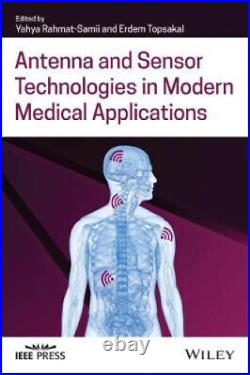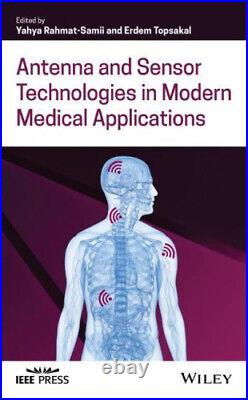Antenna and Sensor Technologies in Modern Medical Applications (IEEE Press)




List of Contributors xvii 1 Introduction 1 Yahya Rahmat-Samii and Erdem Topsakal 2 Ultraflexible Electrotextile Magnetic Resonance Imaging (MRI) Radio-Frequency Coils 11 Daisong Zhang and Yahya Rahmat-Samii 2.1 Introduction to MRI and the Basic Antenna Considerations 11 2.2 Motivations, Challenges, and Strategies for MRI RF Coil Design 15 2.2.1 Design Motivations and Challenges for MRI RF Coils 15 2.2.2 Design Strategies and Roadmap of MRI RF Coils 18 2.3 Selection, Fabrication, and Characterization of Electrotextiles for RF Coils 20 2.3.1 Selection and Fabrication of Flexible Material Candidate 20 2.3.2 Characterization of Electrotextiles 22 2.4 Design of Single-Element Flexible RF Coil 26 2.4.1 RF Coil Element Design with a Rigid Material 26 2.4.2 RF Coil Element Design with Electrotextile Cloth 30 2.4.3 RF Coil Element Design with Tunable Circuitry 31 2.5 Design of Flexible RF Coil Array and System Integration with MRI Scanner 31 2.5.1 RF Coil Array Design and Characterization 32 2.5.2 RF Coil Array System Integration with MRI Scanner 33 2.6 Characterization of RF Coil Array 34 2.6.1 Characterization of RF Coil Array System with Phantom 35 2.6.2 Characterization of RF Coil Array System with Cadaver 38 2.7 Conclusion 38 References 38 3 Wearable Sensors for Motion Capture 43 Vigyanshu Mishra and Asimina Kiourti 3.1 Introduction 43 3.2 The Promise of Motion Capture 45 3.2.1 Healthcare 45 3.2.2 Sports 47 3.2.3 Human-Machine Interfaces 47 3.2.4 Animation/Movies 48 3.2.5 Biomedical Research 48 3.3 Motion Capture in Contrived Settings 49 3.3.1 Camera-Based Motion Capture Laboratory 49 3.3.2 Electromagnetics-Based Sensors 52 3.3.2.1 RADAR Based 52 3.3.2.2 Wi-Fi Based 55 3.3.2.3 RFID Based 57 3.3.3 Magnetic Motion Capture System 59 3.3.4 Imaging Methods 60 3.3.5 Additional Sensors/Tools 60 3.3.5.1 Goniometers 61 3.3.5.2 Force Plates 62 3.4 Wearable Motion Capture (Noncontrived Settings) 63 3.4.1 Inertial Measurement Units (IMUs) 63 3.4.2 Bending/Deformation Sensors 65 3.4.2.1 Strain Based 65 3.4.2.2 Fiber Optics Based 68 3.4.3 Time-of-Flight (TOF) Sensors 70 3.4.3.1 Acoustic Based 70 3.4.3.2 Radio Based 71 3.4.4 Received Signal Strength-based Sensors 73 3.4.4.1 Antenna Based 73 3.4.4.2 Magnetoinductive Sensors/Electrically Small Loop Antennas 74 3.5 Conclusion 78 References 82 4 Antennas and Wireless Power Transfer for Brain-Implantable Sensors 91 Leena Ukkonen, Lauri Sydänheimo, Toni Björninen and Shubin Ma 4.1 Introduction 91 4.2 Implantable Antennas for Wireless Biomedical Devices 92 4.3 Wireless Power Transfer Techniques for Implantable Devices 95 4.3.1 Inductive Power Transfer 95 4.3.2 Ultrasonic Power Transfer 97 4.3.3 Near-Field Capacitive Power Transfer 98 4.3.4 Far-Field Power Transfer 99 4.3.5 Computing the Fundamental Performance Indicators of Near-Field WPT Systems Using Two-Port Network Approach 100 4.4 Human Body Models for Implantable Antenna Development 107 4.4.1 Comparison of Human Head Phantoms with Different Complexities for Intracranial Implantable Antenna Development 110 4.5 Wirelessly Powered Intracranial Pressure Sensing System Integrating Near- and Far-Field Antennas 115 4.5.1 Far-Field Antenna for Data Transmission 116 4.5.2 Antenna for Near-Field Wireless Power Transfer 120 4.6 Far-Field RFID Antennas for Intracranial Wireless Communication 123 4.6.1 Split Ring Resonator-Based Spatially Distributed Implantable Antenna System 123 4.6.2 LC-Tank-Based Miniature Implantable RFID Antenna 127 4.6.3 Antenna Prototype and Wireless Measurement 132 4.7 Conclusion 135 References 136 5 In Vitro and In Vivo Testing of Implantable Antennas 145 Ryan B. Hagness and Nader Behdad 10.1 Introduction 345 10.1.1 Overview of Microwave Ablation Therapy 345 10.1.2 Historical Development and Current Landscape of Research on MWA Antennas 347 10.1.3 Impact of Frequency on MWA Performance 352 10.1.4 Focus of this Chapter 353 10.2 Toward Length Reduction for Ablation Antennas: Demonstration of Higher Frequency Microwave Ablation 354 10.2.1 Electromagnetic Evaluation of Microwave Ablation Antennas Operating in the 1.9-18-GHz Range 354 10.2.2 Performance of Higher Frequency Microwave Ablation in the Presence of Perfusion 355 10.3 Reduced-Diameter, Balun-Equipped Microwave Ablation Antenna Designs 359 10.3.1 Antennas with Conventional Coaxial Baluns Implemented on Air-Filled Coax Sections 361 10.3.2 Coax-Fed Antenna with a Tapered Slot Balun 364 10.4 Balun-Free Microwave Ablation Antenna Designs 367 10.4.1 High-Input Impedance Helical Monopole with an Integrated Impedance-Matching Section 368 10.4.2 Low-Input Impedance Helical Dipole Design 373 10.5 Toward More Flexibility and Customization in Microwave Ablation Treatment 377 10.5.1 Ex Vivo Performance of a Flexible Microwave Ablation Antenna 377 10.5.2 Hybrid Slot/Monopole Antenna with Directional Heating Patterns 380 10.5.3 Non-Coaxial-Based Microwave Ablation Antennas with Symmetric and Asymmetric Heating Patterns 383 10.6 Conclusions 387 References 389 11 Inkjet-/3D-/4D-Printed Nanotechnology-Enabled Radar, Sensing, and RFID Modules for Internet of Things, “Smart Skin, ” and “Zero Power” Medical Applications 399 Manos M. Tentzeris, Aline Eid, Tong-Hong Lin, Jimmy G. Hester, Yepu Cui, Ajibayo Adeyeye, Bijan Tehrani and Syed A. Nauroze 11.1 Introduction 399 11.2 Batteryless “Green” Powering Schemes for Perpetual Wearables 400 11.2.1 Wearable Rectennas Compatible with Legacy Wireless Networks 401 11.2.2 New Opportunities for Power Harvesting from 5G Cellular Networks 402 11.2.2.1 28-GHz Rotman Lens-Based Energy-Harvesting System 402 11.2.2.2 Integration of W-Band Zero-Bias Diode for Harvesting Applications 404 11.3 Additive Manufacturing Technologies for Low-Cost, Compact, and Wearable System 406 11.3.1 Wireless System Packaging for On-Body Devices 406 11.3.2 Energy-Autonomous System-on-Package Designs 407 11.4 Energy-Autonomous Communications for On-Body Sensing Networks 409 11.4.1 Energy-Autonomous Long-Range Wearable Sensor Networks 409 11.4.2 Radar and Backscatter Communications 414 11.4.2.1 FMCW Radar-Enabled Localizable Millimeter-Wave RFID 415 11.4.3 Flexible and Deployable 4D Origami-Inspired “Smart Walls” for EMI Shielding and Communication Applications 416 11.5 Low-Power Sensors for Wearable Wireless Sensing Systems 422 11.5.1 Carbon-Nanomaterials-Based Fully Inkjet-Printed Gas Sensors 422 11.5.2 Energy-Autonomous Micropump System for Wearable and IoT Microfluidic Sensing Devices 425 11.5.3 Fully Inkjet-Printed Encodable Flexible Microfluidic Chipless RFID Sensor 428 11.6 Conclusion 431 References 431 12 High-Density Electronic Integration for Wearable Sensing 435 Shubhendu Bhardwaj, Raj Pulugurtha and John L. Volakis 12.1 Introduction 435 12.2 Brief Comparison of Flexible Conductor Technologies 435 12.3 Review and History of E-Fiber-Based RF Technology 437 12.4 Fabrication of Conductive Flexile E-Fiber Surfaces and Loss Performance 438 12.5 Antennas Using Embroidery-Based Conductive Surfaces 441 12.5.1 Patch Antenna for Wireless Power Transfer and Harvesting 442 12.5.2 Body-Worn Antenna for Wireless Communication 443 12.6 Circuits and Systems Using Embroidery-Based Conductive Surfaces 445 12.6.1 Far-Field Radio-Frequency Power Collection System on Clothing 445 12.6.2 Near-Zone Power Collection Using Fabric-Integrated Antennas 448 12.7 Voltage-Controlled Oscillator for Wound-Sensing Applications 449 12.8 High-Density Integration 451 12.8.1 Interconnect Features on Laminate Substrates 451 12.8.2 Interconnects on Flex Substrates 454 12.8.3 Device Assembly 455 12.8.4 3D Packaging 457 12.8.5 Applications of High-Density Packaging in RF and Sensing 459 12.8.6 High-Density RF Flex Packaging 461 12.8.7 Hybrid Flex Sensor-Processing-Communication Systems 462 References 462 13 Coupling-Independent Sensing Systems with Fully Passive Sensors 469 Siavash Kananian, George Alexopoulos and Ada Poon 13.1 Introduction 469 13.2 Forced vs. Self-Oscillating Near-Field Readout 475 13.3 Readout Techniques 477 13.3.1 Forced Oscillation Techniques with Nonresonant Primary 477 13.3.2 Forced Oscillation Techniques with Resonant Primary 486 13.3.3 Self-Oscillating Techniques 498 13.4 Comparison of the State of the Art 507 13.5 Conclusion 516 References 517 14 Wireless and Wearable Biomarker Analysis 523 Shuyu Lin, Bo Wang, Ryan Shih and Sam Emaminejad 14.1 Introduction 523 14.2 Sweat-Based Biomarkers 524 14.2.1 Metabolites 524 14.2.2 Electrolytes 525 14.2.3 Steroids 525 14.2.4 Proteins 526 14.2.5 Xenobiotics 526 14.3 Wearable Chemical Sensing Interfaces 527 14.3.1 Electroenzymatic Sensors 528 14.3.2 Ion-selective Sensing Interfaces 530 14.3.3 Bioaffinity-based Sensors 531 14.3.4 Synthetic Receptor-based Chemical Sensors 532 14.3.5 Recognition Element-free Sensors 533 14.4 Biofluid Accessibility 533 14.5 Microfluidic Interfaces 534 14.5.1 Types of Microfluidic Interfaces 535 14.5.2 Biofluid Manipulation in Microfluidic Interfaces 536 14.6 Electronic and Wireless Integration 538 References 539 Appendix A Antennas and Sensors for Medical Applications: A Representative Literature Review 547 Lingnan Song and Yahya Rahmat-Samii Index 585.

Related News

Antenna and Sensor Technologies in Modern Medical Applications (IEEE Press)
List of Contributors xvii 1 Introduction 1 Yahya Rahmat-Samii and Erdem Topsakal 2 Ultraflexible ElectrotextileRead More



Comments are Closed